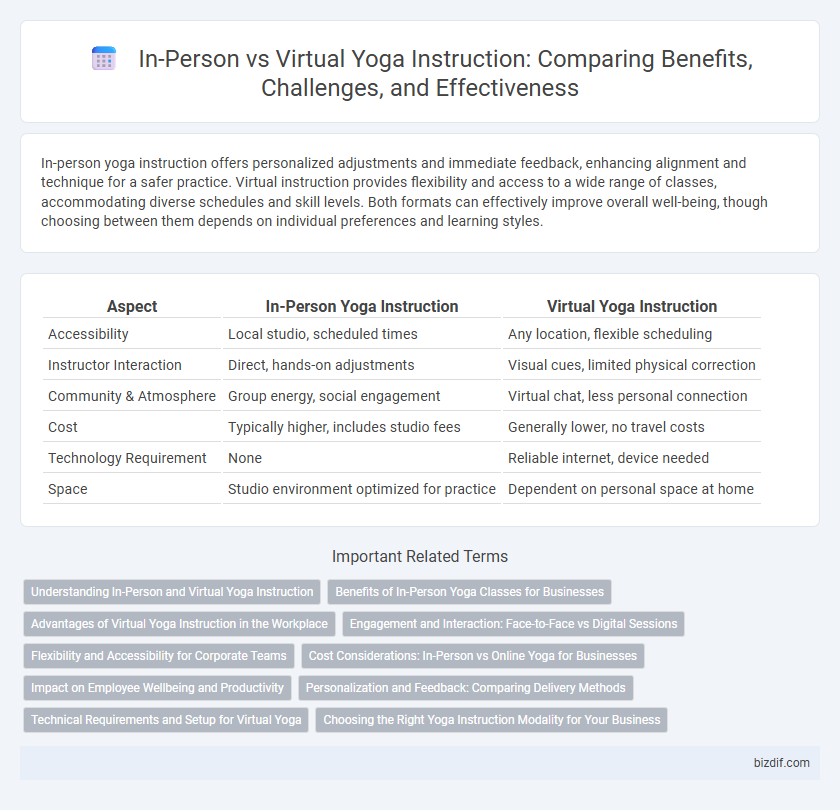In-person yoga instruction offers personalized adjustments and immediate feedback, enhancing alignment and technique for a safer practice. Virtual instruction provides flexibility and access to a wide range of classes, accommodating diverse schedules and skill levels. Both formats can effectively improve overall well-being, though choosing between them depends on individual preferences and learning styles.
Table of Comparison
| Aspect | In-Person Yoga Instruction | Virtual Yoga Instruction |
|---|---|---|
| Accessibility | Local studio, scheduled times | Any location, flexible scheduling |
| Instructor Interaction | Direct, hands-on adjustments | Visual cues, limited physical correction |
| Community & Atmosphere | Group energy, social engagement | Virtual chat, less personal connection |
| Cost | Typically higher, includes studio fees | Generally lower, no travel costs |
| Technology Requirement | None | Reliable internet, device needed |
| Space | Studio environment optimized for practice | Dependent on personal space at home |
Understanding In-Person and Virtual Yoga Instruction
In-person yoga instruction offers direct physical adjustments and immediate feedback, enhancing alignment and preventing injury through real-time guidance. Virtual yoga instruction provides flexibility and access to diverse teaching styles from anywhere, leveraging interactive platforms to maintain engagement and personalized progress tracking. Understanding the strengths of both modes helps practitioners choose the most effective format for their learning preferences and fitness goals.
Benefits of In-Person Yoga Classes for Businesses
In-person yoga classes enhance employee wellness by fostering community and improving focus through direct, hands-on guidance that virtual sessions cannot replicate. Businesses benefit from increased productivity and reduced stress levels as instructors tailor movements and corrections in real time, creating a safer and more engaging environment. Physical presence encourages accountability and consistent participation, driving long-term health improvements and team cohesion.
Advantages of Virtual Yoga Instruction in the Workplace
Virtual yoga instruction in the workplace offers unparalleled convenience by eliminating commute times and allowing employees to participate from their desks or home offices, enhancing accessibility and consistency. Digital platforms facilitate the integration of flexible scheduling, enabling varied session lengths that accommodate diverse workday demands while promoting mental and physical wellness. Remote instruction also broadens participation across global teams, leveraging real-time interaction and digital tools to foster engagement and reduce stress, thereby improving overall employee productivity and job satisfaction.
Engagement and Interaction: Face-to-Face vs Digital Sessions
In-person yoga instruction fosters deeper engagement through real-time physical adjustments and immediate feedback, enhancing alignment and safety. Virtual sessions rely on digital cues and verbal guidance, which may limit tactile interaction but increase accessibility and convenience. Interactive features like live Q&A and breakout rooms in virtual classes partially bridge the engagement gap but do not fully replicate the immersive experience of face-to-face instruction.
Flexibility and Accessibility for Corporate Teams
In-person yoga instruction offers corporate teams a structured environment with direct interaction and real-time corrections, enhancing focus and engagement during sessions. Virtual instruction provides unparalleled flexibility, allowing employees to participate from any location and accommodate varying schedules, which increases overall accessibility. Combining both methods can optimize wellness programs by balancing convenience with personalized guidance.
Cost Considerations: In-Person vs Online Yoga for Businesses
In-person yoga instruction typically incurs higher costs due to venue rental, equipment, and instructor travel expenses, while virtual instruction reduces overhead by eliminating physical space requirements. Businesses often find online yoga sessions more budget-friendly, enabling broader employee participation without geographical limits. However, investment in quality streaming technology and digital platforms is essential to maintain session effectiveness and engagement.
Impact on Employee Wellbeing and Productivity
In-person yoga instruction enhances employee wellbeing by fostering real-time social connection and immediate physical adjustments, which can reduce stress and improve posture, directly boosting productivity. Virtual instruction offers flexibility and accessibility, allowing employees to integrate yoga into their schedules, though it may lack personalized guidance, potentially limiting engagement and long-term benefits. Tailoring yoga programs to workplace needs, whether in-person or virtual, optimizes mental clarity and physical health, resulting in measurable improvements in employee performance and job satisfaction.
Personalization and Feedback: Comparing Delivery Methods
In-person yoga instruction offers personalized guidance through real-time adjustments and hands-on corrections, enhancing posture alignment and technique accuracy. Virtual classes provide flexible access but often lack immediate, tailored feedback, limiting instructors' ability to address individual needs effectively. The direct interaction in face-to-face sessions significantly improves learning outcomes compared to the delayed or generalized feedback common in virtual formats.
Technical Requirements and Setup for Virtual Yoga
Virtual yoga instruction demands a reliable high-speed internet connection, a high-definition camera, and clear audio equipment to ensure seamless interaction and proper form demonstration. Adequate lighting and an uncluttered, quiet space enhance virtual session quality by reducing distractions and improving visibility. Users should also have access to compatible devices such as laptops, tablets, or smartphones with installed video conferencing software to facilitate smooth communication during classes.
Choosing the Right Yoga Instruction Modality for Your Business
Selecting the ideal yoga instruction modality depends on your business goals, target audience, and resources. In-person instruction fosters community engagement and hands-on adjustments, enhancing student experience and retention, while virtual instruction offers scalability and convenience, expanding reach beyond geographical limitations. Evaluate factors such as class size, technology investment, and customer preferences to determine whether in-person, virtual, or a hybrid model best aligns with your yoga studio's growth strategy.
In-Person Instruction vs Virtual Instruction Infographic

 bizdif.com
bizdif.com